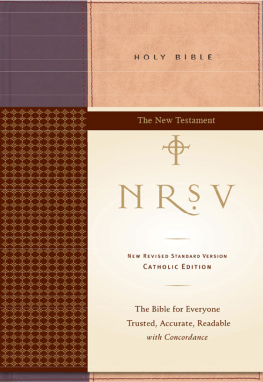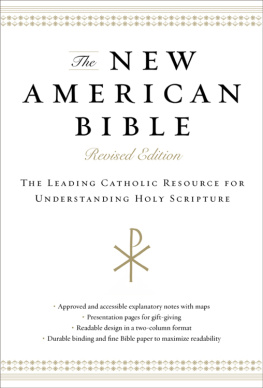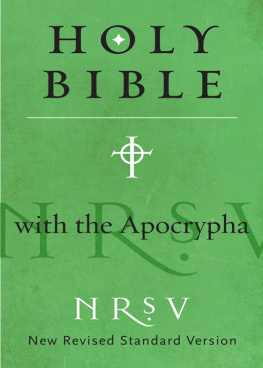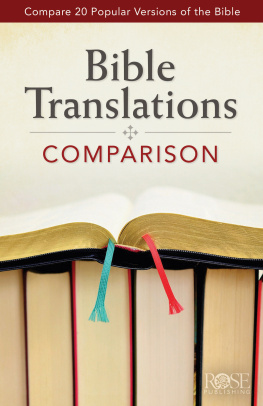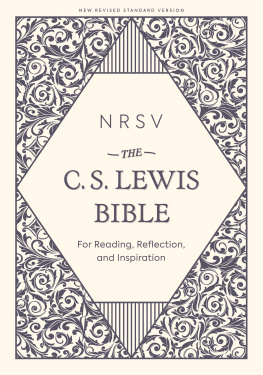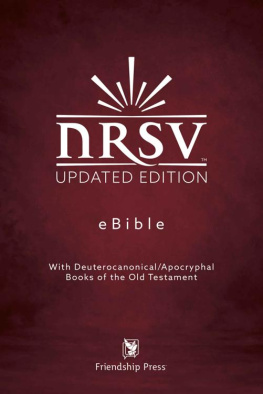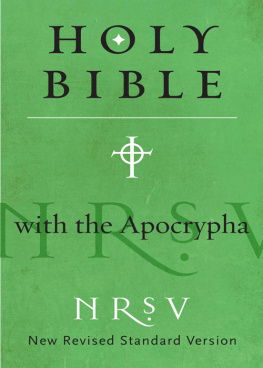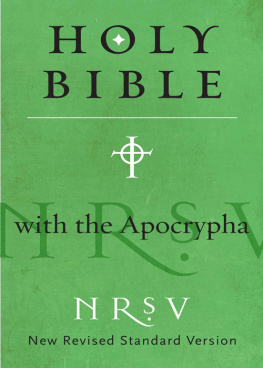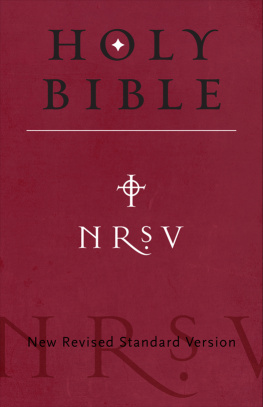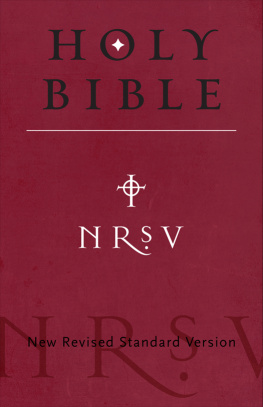THIS CATHOLIC EDITION of the New Revised Standard Version of the Bible has been authorized by the National Conference of Catholic Bishops in the U.S.A. and by the National Council of the Churches of Christ in the U.S.A. It has received the ecclesiastical approval of the Catholic Bishops of both the United States and Canada. The undersigned, who prepared this edition, is a member of the Revised Standard Version Bible Translation Committee as well as an active member and past president of the Catholic Biblical Association of America.
Roman Catholics are already familiar with the accuracy and elegance of the New Revised Standard Version, first published in 1990. It has previously appeared in two major types of edition: an edition of the Old and New Testaments alone, the Bible of most Protestants; and an edition of the Old and New Testaments with the Apocryphal/Deuterocanonical Books placed between the two Testaments. The text of the latter edition received the Imprimatur (official approbation) of the United States and Canadian Catholic Bishops. The New Revised Standard Version is truly an ecumenical translation, for it was produced by Roman Catholic, Eastern Orthodox, Protestant, and Jewish scholars. Because of this Catholic presence no change in the translation was requested for this edition. The only exceptions are the Book of Esther, which exists in two different forms that are explained below, and the Book of Daniel, which includes the deuterocanonical portions that are listed below.
Regarding the number of the books of the Old Testament canon and their arrangement, however, Protestants and Jews on the one hand, and Roman Catholics and Orthodox Christians on the other, hold different beliefs. From the time of the Reformation in the sixteenth century, Protestants have adopted the Jewish canon of the Old Testament, which was established by the rabbis at the end of the first century of the Common Era. This canon includes only those books that were written in Hebrew and Aramaic. In addition to these books, however, Roman Catholics, following the ancient tradition of the Christian church, also hold the Deuterocanonical Books of the Old Testament to be sacred and inspired, and therefore canonical. Protestants and Jews call these books Apocrypha, a word that means hidden or concealed, an inappropriate title for works that were part of the Greek Old Testament (the Septuagint) from pre-Christian times. The Roman Catholic canon, which was fixed by the time of the Council of Hippo in 393 and reaffirmed by the two Councils of Carthage in 397 and 419, was formally defined by the Council of Trent in 1546. This canon contains seven Deuterocanonical Books: Tobit, Judith, the Wisdom of Solomon, Sirach (the Wisdom of Ben Sira, also known as Ecclesiasticus), Baruch including the Letter of Jeremiah as chapter 6, and 1 and 2 Maccabees; and extra portions of two other books: the Additions to Esther; and the Prayer of Azariah and the Song of the Three Jews inserted between verses 23 and 24 of Daniel 3, Susanna as Daniel 13, and Bel and the Dragon as Daniel 14. Over and above these books and extra portions, the Bible of Greek and Slavonic Orthodox Christians includes 1 Esdras, the Prayer of Manasseh, Psalm 151, and 3 Maccabees. The Slavonic Bible also contains 2 Esdras, and an appendix to the Greek Bible includes 4 Maccabees.
Several of the Deuterocanonical Books were written originally in Hebrew or Aramaic, the rest in Greek. More than two-thirds of the Book of Sirach is now extant in Hebrew, and four fragments of the Book of Tobit in Hebrew and Aramaic were recovered from Qumran Cave IV. It seems certain that Judith and the additions to Daniel were also written originally in Hebrew. Hebrew is the original language of the prose parts of Baruch; the poetic parts were composed in Greek. The Wisdom of Solomon was written completely in Greek. The original language of 1 Maccabees was Hebrew while 2 Maccabees was composed in Greek.
The Book of Esther has two different forms: the short Hebrew original; and the longer Greek version that contains one hundred and seven additional verses comprising six distinct portions, A through F. It is the translation of the entire Greek version that appears in the Deuterocanonical section of the New Revised Standard Version. In this Catholic edition, however, the translation of the Greek portions has been inserted at the appropriate places of the translation of the Hebrew form of the book. Some of the Greek portions apparently had a Hebrew origin; the others were written in Greek.
What is distinctive about this Catholic editionas well as every other edition published by Roman Catholicsis that the Deuterocanonical Books and portions are placed in their proper order among the other books of the Old Testament. Thus, Tobit, Judith, the long form of Esther, and 1 and 2 Maccabees are found among the so-called historical books directly after Nehemiah. The Wisdom of Solomon and the Book of Sirach follow after the Song of Solomon among the wisdom books. Because Baruch, the well-known secretary of Jeremiah, is said to be the author of the work that bears his name, the book is placed after Jeremiah and Lamentations. This order of books comes from the Latin Vulgate translated by St. Jerome in the late fourth and early fifth centuries. It is essentially the same order as that found in the fourth-century Codex Vaticanus, one of the oldest extant manuscripts of the Septuagint.
Roman Catholics will welcome this edition of the New Revised Standard Version of the Bible for personal reading and study as well as liturgical usage. Based on the latest manuscript discoveries and critical editions, it offers the fruits of the best biblical scholarship in the idiom of today while being sensitive to the contemporary concern for inclusive language when referring to human beings.
A LEXANDER A. D I L ELLA , O.F.M.
Andrews-Kelly-Ryan Distinguished Professor of Biblical Studies
The Catholic University of America
September 30, 1992
Feast of St. Jerome
THE PUBLICATION of the New Revised Standard Version of the Bible in 1990 marked the latest stage in the development of an authoritative English language text, a process that started in England with the translation commonly known as the Authorized or King James Version of 1611. The ongoing task of translation had already resulted in the Revised Standard Version of 1952, and a fuller account of this developmental process can be found in the preface To the Reader.
The RSV rapidly found favour throughout the English-speaking world, and in the United Kingdom the translation was quickly adopted by churches, theological colleges, and university faculties as their standard version. In all these places, the RSV was recognized as being authoritative and accurate, impartial in its scholarship, and well-suited to the needs of the Christian community of that period.

